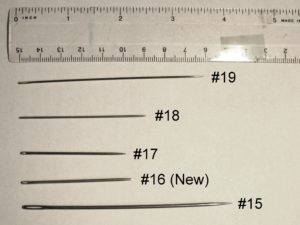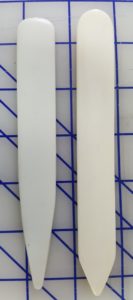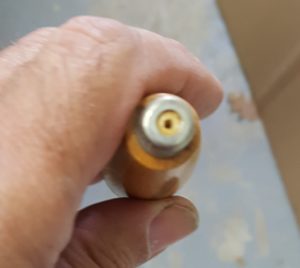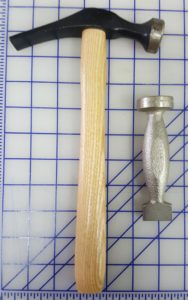Folders
These tools are used to assist in folding sheet materials such as paper, cloth, and leather, and can also be used to produce a rough-edged cut in a sheet of paper. The tip can also be used to score a crease before folding, or to shape and press down the inside corner of a crease that would otherwise be hard to reach, and the side of the folder can be used to flatten down creases and to press two pieces of sheet material into close contact when pasting.
We have genuine bone folders and synthetic ones made from nylon. The bone folders are heavier, more durable, less likely to leave residue or burnish marks on the paper, and generally have a nicer feel in the hand than the nylon folders.
Awls
Awls are used to put small holes in sheet materials. They do not cut out any of the material to make the hole, though; instead they tear out a tiny hole and then compress the material forward and laterally to enlarge the hole. This is distinct from our paper drill (below) which actually cuts out a section of the material to form the hole.
We sell a small awl, as well as an awl haft (handle). To use the haft, insert a needle of the desired size into the hole in the end of the handle and use a bit of glue if necessary to secure it.
The awl tip is tapered and so the hole will become larger as you push it in further, but when using the awl haft the hole gets no larger than the body of the needle you’ve used. The taper of the awl tip limits how thick a stack of material you can punch and still expect the hole in the top layer to be reasonably similar in size to the hole in the bottom layer, but using a needle in the awl haft provides a consistent hole size through even a relatively thick stack of material.
The awl haft is a good way to make use of a needle whose eye has broken.
Hammers
Hammers are used to shape book spines, to flatten creases and stitching, and to force pasted materials into very close contact.
Both of the hammers we sell have a wide slightly domed face and a blunt chisel-like shape on the other end.
The backing hammer is held by the handle as with most hammers, but for precision work and a soft blow one might choke down on the handle (hold it very close to the head).
The fitter’s hammer provides the ultimate in choking down on the handle, since all you have is the head which you grip by its centre in your fist.
Both hammers have heads weighing about 360g (13 ounces).
Paper Drill (Hole Punch)
 This tool is used to punch clean round holes in leather, board, and other such soft materials, as well as in stacks of paper. It includes interchangeable cutter tips for 3, 4, and 6mm holes. It is unfortunate that this don’t come with a 5mm cutter, which would be ideal for use with most binding posts (Chicago screws).
This tool is used to punch clean round holes in leather, board, and other such soft materials, as well as in stacks of paper. It includes interchangeable cutter tips for 3, 4, and 6mm holes. It is unfortunate that this don’t come with a 5mm cutter, which would be ideal for use with most binding posts (Chicago screws).
Unlike a standard office hole punch, which uses a shearing action similar to that of scissors to push the chad out the back of the material, this punch acts more like a chisel: a sharp edge cuts downward, and the chad (the “confetti” from the hole) is pushed aside. As there isn’t really much aside to push to, the chad get pushed up into the inside of the hollow cutter, where further punching pushes it along and it eventually emerges into the handle of the punch. To allow for some strength in the cutter, the hole inside tapers to be smaller than the punched hole, so the chads get compressed a bit.
There are other manual hole drills with a similar cutting action, but many of these other cutters have a straight-sided inside hole for easy passage of the chads, and are tapered on the outside. This means that if such drills are used on thick inelastic material, the resulting hole will be stretched. Thus in board you would get a cone-shaped hole, and in a stack of paper, the holes would vary somewhat in size. In contrast, our hole drill gives consistent straight-sided holes.
In order to assist with the cutting action, the cutter should be rotated. There exist power hole drills which rotate their cutter continuously, and some manual paper drills have a mechanism so they twist automatically when you push down, but ours requires manual rotation.
Needles
 We sell five sizes of needles as shown here. They are available either singly or in 3-packs. Please note that these needles are all straight; the photo has a bit of distortion which makes the two longest ones appear curved.
We sell five sizes of needles as shown here. They are available either singly or in 3-packs. Please note that these needles are all straight; the photo has a bit of distortion which makes the two longest ones appear curved.




